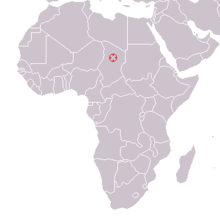KT 12
KT 12 is the name of a site of pliocene and Pleistocene fossils in northern Chad , not far from the town of Koro Toro (hence the abbreviation KT) and the site KT 13 . As a result of soil erosion , the Quaternary soil layer that predominates elsewhere in the Chad Basin has been lost, so that older layers are now on the surface. The scientific significance of the site is primarily the evidence of a much larger distribution area of the genus Australopithecus than previously known.
The finds
The KT 12 site on the river bed of the Bahr al Ghazal ( Arabic : river of the gazelles ) was investigated by paleoanthropologists led by excavation manager Michel Brunet from 1994 , and the discovery of an Australopithecus mandible was announced as early as November 1995 . The fossil was dated with the help of biochronological findings to an age of 3.5 to 3.0 million years and was the first evidence of the colonization of northern Central Africa by a species of the genus Australopithecus ; Until then, such fossils were only known from the Great African Rift Valley around 2500 kilometers to the east and from South Africa . In 1996 the lower jaw (archive number KT 12 / H1) was named as the holotype of the new species Australopithecus bahrelghazali .
The KT 12 site consists of the superficial remains of a formerly slowly flowing body of water. Proof of this are on the one hand the angular, not rounded quartz stones embedded in fine, only weakly consolidated sandstone, as well as other traces of a watercourse; on the other hand, the discovery of fish fossils and a fossil white rhinoceros ( Ceratotherium praecox ), the bones of which were still in their original arrangement. Also found were: catfish , tortoises (genus Geochelone ) and softshell turtles (genus Trionyx ), crocodiles (genus Tomistoma ), elephants ( Loxodonta exoptata , similar to those from Laetoli and Hadar ), several horse species of the genus Hipparion , cattle giraffes ( Sivatherium ), Waterbuck , relatives of today's hartebeest (Alcelaphini) and cattle , pigs ( Kolpochoerus afarensis ) and hippos ( Hexaprotodon protamphibius turkanensis , similar to those from the lower reaches of the Omo ) - finds that are evidence of a partly savannah-like ( Ceratotherium , Hipparion ), partly stronger wooded landscape ( Loxodonta , waterbuck, Kolpochoerus ) were interpreted during the life of the animals as a presumed gallery forest along a calm, flowing water, extended to a lake in the middle of a loosely wooded grassy landscape . Later, the discovery of fish from the group of perch-like species as well as ducks , otters , stegodons and giraffes was published .
Starting in 1996, the approximately 20 hectare site KT 13 (geodata: 15 ° 58 '09 N; 18 ° 52' 10 E) east of Koro Toro was searched for fossils that were also between 3.5 and 3 .0 million years ago. The nature of the fossil soil also indicated a formerly calm body of water, as the bones of numerous fossils (around 30 species) were still found in the original compound and have a species spectrum almost identical to that of KT 12. However, some additional species were identified, including, for example, one species each of the hyenas , the wildcats , the martens and the otters ( Enhydriodon ) as well as an unspecified primate fossil that was ascribed to Australopithecus .
Historical
Pliocene and Pleistocene fossil sites were known from the Borkou-Ennedi-Tibesti region in northern Chad since 1959; the composition of the mammal fossils was interpreted to mean that their owners inhabited a habitat consisting of partly open savannahs and partly forests during their lifetime . In 1965 Yves Coppens reported the discovery of fragments of a hominine facial skull, which he initially referred to as "Tchadanthropus uxoris" and which is now attributed to Homo erectus . Intermittently interrupted by the Chadian civil war and the annexation of parts of northern Chad by Libya , field research was expanded from 1993 after 17 new fossil sites, including KT 12 and KT 13, were discovered at Koro Toro. In 1997, around 40 fossil sites had already been discovered.
The holotype of Sahelanthropus was also found in northern Chad - at the TM 266 site .
Individual evidence
- ↑ a b c Michel Brunet , Alain Beauvilain, Yves Coppens , Emile Heintz, Aladji HE Moutaye and David Pilbeam : The first australopithecine 2,500 kilometers west of the Rift Valley (Chad). In: Nature . Volume 378, 1995, pp. 273-275, doi: 10.1038 / 378273a0
- ↑ Michel Brunet et al .: Australopithecus bahrelghazali, une nouvelle espèce d'Hominidé ancien de la région de Koro Toro (Tchad). In: Comptes Rendus de l'Academie de Sciences - Series IIa: Sciences de la Terre et des Planetes. Volume 322, No. 10, 1996, pp. 907-913. Full text (PDF)
- ↑ Julia Lee-Thorp et al .: Isotopic evidence for an early shift to C 4 resources by Pliocene hominins in Chad. In: PNAS . Volume 109, No. 50, 2012. pp. 20369-20372, doi: 10.1073 / pnas.1204209109
- ↑ a b Michel Brunet et al .: Tchad: un nouveau site à Hominidés Pliocène. In: Comptes Rendus de l'Academie de Sciences Paris. Volume 324, Series IIa, 1997, pp. 341-345
- ^ J. Abadie, J. Barbeau, Y. Coppens: Une faune de Vertébrés villafranchiens au Tchad. In: Comptes Rendus de l'Academie de Sciences. Volume 248, 1959, pp. 3328-3330.
- ↑ Yves Coppens : L'you hominien Tchad. In: Comptes Rendus de l'Academie de Sciences. Volume 260, Series D, 1965, pp. 2869-2871.
- ^ Jon E. Kalb: Adventures in the Bone Trade: The Race to Discover Human Ancestors in Ethiopia's Afar Depression. Copernicus Books, New York 2001, p. 76, ISBN 0-387-98742-8
Coordinates: 15 ° 34 ′ 51.6 ″ N , 18 ° 31 ′ 28.6 ″ E
